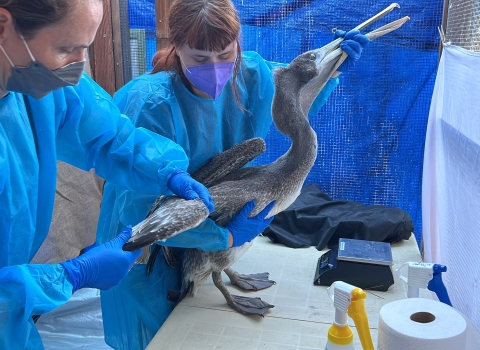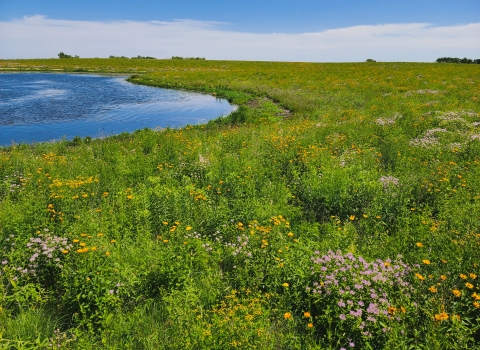DENVER – The U.S. Fish and Wildlife Service (Service) today announced the availability of an Incidental Take Permit (ITP) application submitted by BNSF Railway (BNSF) for the take of grizzly bears, listed as threatened under the Endangered Species Act (ESA). The application includes BNSF’s proposed habitat conservation plan (HCP), which outlines measures the company will take to reduce impacts to grizzly bears.
If issued, the permit would authorize the take of approximately 18 grizzly bears incidental to BNSF Railway operations during a seven-year period on 206 miles of railway between Trego and Shelby, Montana.
“We are proud to be formalizing this Habitat Conservation Plan with BNSF Railway to help minimize impacts to grizzly bears and to foster shared conservation efforts,” said Jodi Bush, the Service’s Montana Project Leader. “We also thank our partners at the Blackfeet Nation Fish & Wildlife Department; Montana Fish, Wildlife & Parks; Glacier National Park; and the U.S. Forest Service for their years of committed assistance and continued partnership.”
Under Section 10(a)(1)(B) of the ESA, the Service is authorized to issue ITPs to private, non-federal entities for “take” of a listed species that results from otherwise lawful activity. An ITP must include an HCP to minimize and mitigate harm to the impacted species. As part of the review process, the Service evaluated the application for compliance with the National Environmental Policy Act (NEPA). This evaluation determined that the project does not have a significant effect on the human environment, resulting in a categorical exclusion from further NEPA requirements.
“This marks an important milestone in BNSF Railway’s longstanding efforts to minimize impacts to grizzly bears from train operations in Northwest Montana,” said John Lovenburg, Environmental Vice President of BNSF Railway. “We appreciate the years of commitment from partners including U.S. Fish & Wildlife Service; Montana Fish, Wildlife & Parks; the Blackfeet Nation; and Glacier National Park in advising on and developing the minimization and mitigation measures included in the Habitat Conservation Plan. We look forward to continued efforts to implement the plan, support ongoing bear recovery efforts and to focus on our goal of avoiding grizzly bear mortalities.”
Since 1991, BNSF has collaborated with tribal, federal, state and local government agencies, conservation groups and industry to address and mitigate concerns about grizzly bear mortality due to railroad operations. These efforts include agreements to implement programs and measures to minimize bear and train conflicts, primarily by identifying and removing attractants from right-of-way and installing deterrents in high-risk areas. As part of this, BNSF has implemented a rapid-response program for grain spills, the primary attractant for bears to railways, and expanded education of railway employees.
The ITP and associated HCP formalize these ongoing efforts by BNSF to promote grizzly bear conservation. The HCP also proposes additional financial support for personnel, equipment and education to reduce human-bear conflicts. This funding would be directed to efforts by the Blackfeet Nation and Montana Fish, Wildlife & Parks.
“The Habitat Conservation Plan represents years of local conservation collaboration among BNSF Railway, public agencies, tribes and local communities across northwest Montana,” said Jim Williams, Regional Supervisor for Montana Fish, Wildlife & Parks (FWP). “This plan will commit important funding that increases resources for on-the-ground conservation work. FWP is grateful that BNSF is supporting the future of grizzly bear recovery.”
The notice of availability for the ITP, HCP and associated NEPA documentation is available today for public inspection in the Reading Room and will publish in the Federal Register on the next business day, opening a 30-day public comment period.
Comments may be submitted electronically on www.regulations.gov by searching Docket Number: FWS–R6–ES–2019–0010. To submit comments by hard copy mail, or hand-deliver to: Public Comments Processing, Attn: Docket No. FWS–R6–ES–2019–0010, Division of Policy, Performance, and Management; U.S. Fish and Wildlife Service; 5275 Leesburg Pike, ABHC-PPM; Falls Church, VA 22041-3803.
The mission of the U.S. Fish and Wildlife Service is working with others to conserve, protect, and enhance fish, wildlife, plants, and their habitats for the continuing benefit of the American people. For more information on our work and the people who make it happen in the West, visit our website, or connect with us through any of these social media channels: Facebook, Twitter, Flickr, YouTube, and Instagram.


